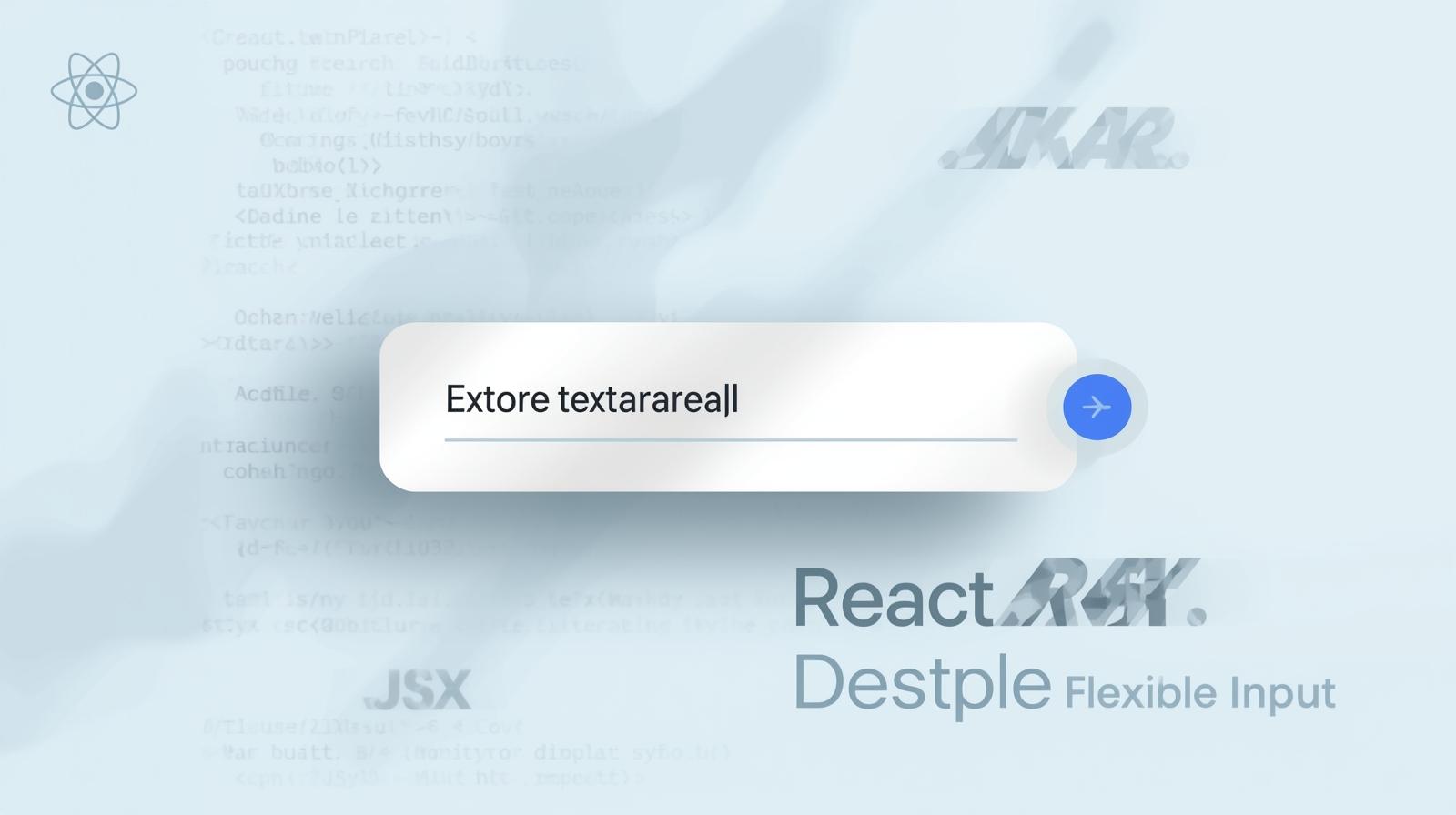Mastering React Textarea: A Complete Guide with Examples & Best Practices

Learn how to effectively use the React Textarea tag. This in-depth guide covers controlled components, validation, dynamic height, and best practices for professional forms.

Mastering React Textarea: A Complete Guide with Examples & Best Practices
Mastering the React Textarea: From Basic Input to Dynamic User Experiences
If you've ever built a form in a web application, you've almost certainly reached for a <textarea>. It's the go-to element for capturing longer-form user input—think blog post comments, user profiles, product descriptions, or support tickets. But if you're working in React, a simple HTML element isn't quite so simple anymore. How do you manage its state? How do you validate it? And how can you make it dynamically grow with the user's input?
Welcome to your one-stop, in-depth guide to mastering the <textarea> in React. We're going to move beyond the basics and explore how to handle this essential form element like a professional developer. By the end of this article, you'll be able to build robust, user-friendly, and accessible textareas for any scenario.
The Foundation: Understanding Controlled vs. Uncontrolled Components
This is the single most important concept in React forms. You have two ways to deal with form data:
Uncontrolled Components: This is the traditional HTML way. The DOM itself holds the current value. You can get the value when you need it, typically using a
ref.Controlled Components: This is the "React way." The source of truth for the input's value is React state. You control the input's value by setting it explicitly, and you handle changes via an
onChangehandler.
For most use cases, controlled components are the recommended approach. They make your UI more predictable and integrate seamlessly with form validation and submission logic.
Building Your First Controlled Textarea
Let's start with the fundamental pattern. We'll create a simple comment form.
jsx
import React, { useState } from 'react';
const CommentForm = () => {
// 1. Create a state variable to hold the textarea's value
const [comment, setComment] = useState('');
// 2. Handler to update state on every keystroke
const handleCommentChange = (event) => {
setComment(event.target.value);
};
// 3. Handler for form submission
const handleSubmit = (event) => {
event.preventDefault();
alert(`Your comment: ${comment}`);
// Here, you would typically send 'comment' to an API
};
return (
<form onSubmit={handleSubmit}>
<label htmlFor="commentText">
Leave your comment:
</label>
{/* 4. The controlled textarea: value is set by state, changes are handled by our function */}
<textarea
id="commentText"
value={comment}
onChange={handleCommentChange}
rows={5}
cols={50}
/>
<button type="submit">Submit Comment</button>
</form>
);
};
export default CommentForm;Let's break down the key steps:
State:
useState('')initializes ourcommentstate as an empty string.Handler:
handleCommentChangeis called on every change to the textarea.event.target.valuegives us the current text, and we update our state with it.Linking it together: The
value={comment}prop makes this a controlled component. The textarea will always display whatever value is in thecommentstate. TheonChange={handleCommentChange}prop ensures that when the user types, the state is updated, which in turn re-renders the textarea with the new value.
This pattern gives you complete control over the input's value.
Leveling Up: Real-World Use Cases and Enhancements
A basic textarea is functional, but a great user experience requires more. Let's look at some common real-world requirements.
1. Form Validation and User Feedback
You don't want users submitting an empty comment or exceeding a character limit. Let's add validation.
jsx
const CommentFormWithValidation = () => {
const [comment, setComment] = useState('');
const [error, setError] = useState('');
const handleCommentChange = (event) => {
const newComment = event.target.value;
setComment(newComment);
// Simple validation logic
if (newComment.trim() === '') {
setError('Comment cannot be empty.');
} else if (newComment.length > 200) {
setError(`Comment must be less than 200 characters. (${newComment.length}/200)`);
} else {
setError(''); // Clear error if valid
}
};
const handleSubmit = (event) => {
event.preventDefault();
if (error || comment.trim() === '') {
alert('Please fix the errors before submitting.');
return;
}
// Proceed with submission
console.log('Submitting:', comment);
};
return (
<form onSubmit={handleSubmit}>
<label htmlFor="commentText">Your Comment:</label>
<textarea
id="commentText"
value={comment}
onChange={handleCommentChange}
rows={5}
cols={50}
// Aria attribute for accessibility
aria-describedby="commentError"
// Optional: style border if there's an error
style={{ border: error ? '1px solid red' : '1px solid #ccc' }}
/>
{/* Display character count */}
<div>{comment.length}/200</div>
{/* Display error message */}
{error && <div id="commentError" style={{ color: 'red' }}>{error}</div>}
<button type="submit">Submit</button>
</form>
);
};2. Creating a Dynamic, Auto-Resizing Textarea
Have you seen textareas that grow in height as you type, like the one on Twitter or Facebook? This is a fantastic UX improvement. We can achieve this by dynamically adjusting the height CSS property based on the textarea's scrollHeight.
jsx
import React, { useState, useRef } from 'react';
const AutoResizingTextarea = () => {
const [value, setValue] = useState('');
const textareaRef = useRef(null);
const handleChange = (event) => {
const newValue = event.target.value;
setValue(newValue);
// Auto-resize logic
const textarea = textareaRef.current;
if (textarea) {
textarea.style.height = 'auto'; // Reset height to recalculate scrollHeight
textarea.style.height = `${textarea.scrollHeight}px`; // Set to its content height
}
};
return (
<textarea
ref={textareaRef}
value={value}
onChange={handleChange}
style={{ minHeight: '50px', resize: 'none' }} // 'resize: none' prevents manual resizing
placeholder="Type something here..."
/>
);
};This technique provides a seamless experience that users love.
Best Practices for Professional-Grade Textareas
Always Use a
<label>: This is crucial for accessibility. Use thehtmlForattribute to associate the label with the textarea'sid.Leverage
placeholderWisely: A placeholder can provide context, but don't use it as a replacement for a label. It should be a hint, not the primary instruction.Consider Accessibility (a11y): Use
aria-describedbyto link the textarea to helper text or error messages. This helps screen reader users understand the context.Manage
resizeCSS Property: Useresize: vertical;orresize: none;based on your design needs. Allowing only vertical resizing can prevent layout breaks.Debounce for Performance: If you're doing expensive operations on every keystroke (like live search or complex validation), consider "debouncing" the
onChangehandler to limit how often it fires.
Mastering these patterns is what separates a beginner from a professional developer. The ability to take a simple HTML element and weave it into a reactive, validated, and accessible component is a core skill in modern web development.
To learn professional software development courses such as Python Programming, Full Stack Development, and MERN Stack, visit and enroll today at codercrafter.in. Our project-based curriculum is designed to help you master these exact concepts and build a impressive portfolio.
Frequently Asked Questions (FAQs)
Q1: Can I use the defaultValue prop with a textarea?
Yes, but only for uncontrolled components. It sets the initial value, but you lose the benefits of React state control. For controlled components, set the initial value in your useState hook (e.g., useState('Initial text')).
Q2: How do I make a textarea required?
Just like in HTML, use the required prop: <textarea required ... />. However, for a better user experience, combine this with client-side validation and clear error messages, as shown in the examples above.
Q3: What's the difference between value and defaultValue?value is for controlled components. You must provide an onChange handler to update it. defaultValue is for uncontrolled components and is only used once to set the initial value.
Q4: My textarea isn't updating when I type. What's wrong?
This is the most common pitfall! You've created a controlled component but made it "read-only." You have a value prop set to a state variable, but you are missing the onChange handler to update that state. Double-check that you have both.
Conclusion
The humble <textarea> is a powerful tool in your React arsenal. By embracing the controlled component pattern, you unlock the full potential of React's state-driven architecture. From there, you can layer on essential features like real-time validation, dynamic styling, and accessible feedback to create forms that are not just functional, but a pleasure to use.
Remember, great UX is in the details. A well-implemented textarea is a small but significant step towards building professional, user-centric applications.
Feeling inspired to build more? This deep dive into form handling is just a fraction of what you'll master in a comprehensive program. If you're ready to transform your ideas into fully-functional web applications, explore the advanced courses offered at codercrafter.in. From foundational Python to the complete MERN Stack, we provide the structure and mentorship you need to succeed.









